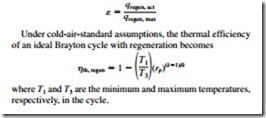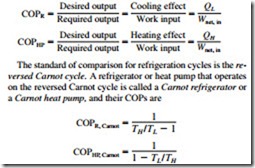SUMMARY
The most efficient cycle operating between a heat source at temperature TH and a sink at temperature TL is the Carnot cycle, and its thermal efficiency is given by
The actual gas cycles are rather complex. The approximations used to simplify the analysis are known as the air-standard assumptions. Under these assumptions, all the processes are assumed to be internally reversible; the working fluid is assumed to be air, which behaves as an ideal gas; and the combustion and exhaust processes are replaced by heat-addition and heat- rejection processes, respectively. The air-standard assumptions are called cold-air-standard assumptions if, in addition, air is assumed to have constant specific heats at room temperature.
In reciprocating engines, the compression ratio r and the mean effective pressure MEP are defined as
where rc is the cutoff ratio, defined as the ratio of the cylinder volumes after and before the combustion process.
The ideal cycle for modern gas-turbine engines is the Bray- ton cycle, which is made up of four internally reversible processes: isentropic compression, constant-pressure heat addition, isentropic expansion, and constant-pressure heat rejection.
Under cold-air-standard assumptions, its thermal efficiency is
where rp = Pmax/Pmin is the pressure ratio and k is the specific heat ratio. The thermal efficiency of the simple Brayton cycle increases with the pressure ratio.
The deviation of the actual compressor and the turbine from the idealized isentropic ones can be accurately accounted for by utilizing their isentropic efficiencies, defined as
where states 1 and 3 are the inlet states, 2a and 4a are the actual exit states, and 2s and 4s are the isentropic exit states.
The Otto cycle is the ideal cycle for the spark-ignition reciprocating engines, and it consists of four internally reversible processes: isentropic compression, constant-volume heat addition, isentropic expansion, and constant-volume heat rejection. Under cold-air-standard assumptions, the thermal efficiency of the ideal Otto cycle is
The Carnot cycle is not a suitable model for vapor power cycles because it cannot be approximated in practice. The model cycle for vapor power cycles is the Rankine cycle, which is composed of four internally reversible processes: constant- pressure heat addition in a boiler, isentropic expansion in a turbine, constant-pressure heat rejection in a condenser, and isentropic compression in a pump. Steam leaves the condenser as a saturated liquid at the condenser pressure.
The thermal efficiency of the Rankine cycle can be increased by increasing the average temperature at which heat is added to the working fluid and/or by decreasing the average temperature at which heat is rejected to the cooling medium. The average increased, the expansion and reheat processes approach an isothermal process of expansion at maximum temperature. Re- heating also decreases the moisture content at the turbine exit. The transfer of heat from lower-temperature regions to higher-temperature ones is called refrigeration. Devices that produce refrigeration are called refrigerators, and the cycles on which they operate are called refrigeration cycles. The working fluids used in refrigerators are called refrigerants. Refrigerators used for the purpose of heating a space by transferring heat from a cooler medium are called heat pumps.
The performance of refrigerators and heat pumps is expressed in terms of coefficient of performance (COP), defined as temperature during heat rejection can be decreased by lowering the turbine exit pressure. Consequently, the condenser pressure of most vapor power plants is well below the atmospheric pressure. The average temperature during heat addition can be increased by raising the boiler pressure or by superheating the fluid to high temperatures. There is a limit to the degree of superheating, however, since the fluid temperature is not allowed to exceed a metallurgically safe value.
Superheating has the added advantage of decreasing the moisture content of the steam at the turbine exit. Lowering the exhaust pressure or raising the boiler pressure, however, in-creases the moisture content. To take advantage of the improved efficiencies at higher boiler pressures and lower condenser pressures, steam is usually reheated after expanding partially in the high-pressure turbine. This is done by extracting the steam after partial expansion in the high-pressure turbine, sending it back to the boiler where it is reheated at constant pressure, and returning it to the low-pressure turbine for complete expansion to the condenser pressure. The average temperature during the reheat process, and thus the thermal efficiency of the cycle, can be increased by increasing the number of expansion and reheat stages. As the number of stages is
The most widely used refrigeration cycle is the vapor-compression refrigeration cycle. In an ideal vapor-compression refrigeration cycle, the refrigerant enters the compressor as a saturated vapor and is cooled to the saturated liquid state in the condenser. It is then throttled to the evaporator pressure and vaporizes as it absorbs heat from the refrigerated space.



